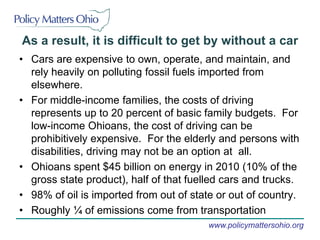Ohioans for transportation choice
- 1. Ohioans for Transportation Choice Alliance for Regional Transit The People’s Department of – Cincinnati Transportation www.policymattersohio.org
- 2. Ohio Transportation Budget • Transportation budget expected on Feb. 6 • Biennial: FY 2014 & FY 2015 • Roughly $8 billion for two years • State gas tax and motor-vehicle fees are prohibited by Ohio Constitution to go towards anything but roads and highways • Federal transportation funds are more flexible • Transportation budget typically moves fast through the legislature www.policymattersohio.org
- 3. Why the State’s Transportation Budget Matters • Ohio’s transportation system is the direct result of decisions made on how we allocate state transportation dollars. • For decades, Ohio has underinvested in public transit and other transportation options. • Nearly all of our transportation dollars go towards road, highway and bridge projects • 1% of state transportation funds went to public transit in previous budget (FY 2012/13) • Ohio ranks 47th in the nation for its commitment to public transit, despite being the 7th most populous state. www.policymattersohio.org
- 4. As a result, it is difficult to get by without a car • Cars are expensive to own, operate, and maintain, and rely heavily on polluting fossil fuels imported from elsewhere. • For middle-income families, the costs of driving represents up to 20 percent of basic family budgets. For low-income Ohioans, the cost of driving can be prohibitively expensive. For the elderly and persons with disabilities, driving may not be an option at all. • Ohioans spent $45 billion on energy in 2010 (10% of the gross state product), half of that fuelled cars and trucks. • 98% of oil is imported from out of state or out of country. • Roughly ¼ of emissions come from transportation www.policymattersohio.org
- 5. Ohioans need more transportation choices • To reduce our vulnerability to spikes in oil price • To offer more affordable, accessible, safe, and environmentally-friendly options • Make our transportation system more economically sustainable, and reduce the amount of energy dollars leaving our state each year to purchase oil • Reduce emissions from the transportation sector • Investments to create a network of alternative transportation choices will also spur economic development, employ people, reduce urban sprawl and congestion, and create more livable communities www.policymattersohio.org
- 6. Ohioans for Transportation Choice • Calling on the state to create a “Transportation Choice” Fund. • Set aside $75 million each year in flexible federal funding out of the state’s transportation budget • Can be used for alternative transportation options such as public transit, infrastructure for biking, walking, and electric vehicles, passenger and freight rail, and streetcars. • Ramp up Transportation Choices funding to 10% of the transportation budget by 2020. www.policymattersohio.org






